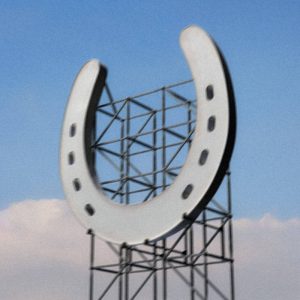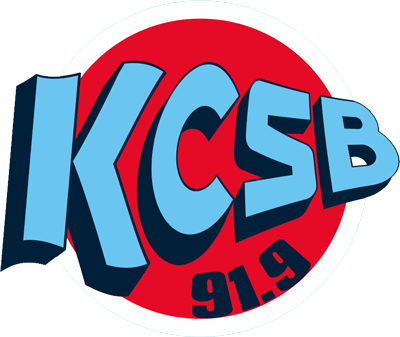November Add of the Month: “Wallsocket” by Underscores
Words by: Bella Genolio 
For November’s add of the month, KCSB’s External Music Director, Bella Genolio, highlights the album “Wallsocket” by underscores
Wallsocket, MI is a rural midwestern town rich in history and community. Historically, Wallsocket was a highly profitable area for horse breeders and ranchers due to its vast amounts of grazing land and proximity to Detroit. As industrialization spread across the US, the equestrian market declined and the town began to experience an economic downturn. Though horse breeding may not be the main economic force in the town, Wallsocket has retained its equestrian history and continues to honor it. There’s a giant horseshoe overlooking the town, summer camps with horse related activities, and an equestrian team that regularly brings back the state championship. To read more about Wallsocket’s history, check out the town’s website. Or perhaps you want to get to know the people of Wallsocket, read what the moms have to say on their blog or check out the Waterworks Weekly, a student-run newspaper. You can even see what their grocery store has to offer on Oxbow’s Market’s website. You can do everything except visit, because despite all records of the town, Wallsocket does not exist.
Wallsocket is a project from Filipina-American artist April Harper Grey, who uses the alias underscores on her albums. Growing up in San Francisco, Grey began composing at the age of six and started releasing music at the age of thirteen. She released her debut studio album, Fishmonger, in 2021 and also began touring with 100 gecs as their opener in 2021.
This project is a vast amalgamation of different elements, genres, backgrounds, and sounds; the expansiveness of this project is reminiscent of other encyclopedic works like House of Leaves or Twin Peaks. The album itself is a mix of hyper-pop, noise, folk, ambience – it’s a bright explosion of digital maximalism that bleeds out over the edges of the actual album into many reaches of the internet.
As you look deeper into the project, more sinister parts of the town begin to arise. Maddison Smith, a student writer with Waterworks Weekly, attempts to downplay the severity of a group of highschool students poisoning their teacher. Sadie R. from Moms of Wallsocket shares concerns about the safety of the town’s children. The Town Hall discusses the potential danger of having children participate in equestrian jousting and Jineteada Gaucha, a traditional gaucho sport that involves trying to stay on an untamed horse for a number of seconds. Even more horrors of the town are revealed in the album itself through each song.
Wallsocket kicks off with a bright, punchy, hyperpop anthem, “Cops and Robbers.” This track tells of a trusted bank teller who has been embezzling for over a decade, gets caught, and flees town to leave his history of fraud behind. The repeated lyric “you gotta do it, gotta do it, gotta do it like me” feeds into the thrill that the narrator experiences and points to an addiction to the rush it brings. This track is centered around addiction, the narrator initially began to embezzle to “pay for the crystal,” and the music video for this song shows teens from the town buying and selling drugs. The exposure of this fraud definitely shakes the town, and community members share on both the blog and the school newspaper their newfound sense of paranoia. The overall consensus from the community members was, “Stuff like that doesn’t happen here;” the town’s desire to suppress its evident drug problem rather than attempt to fix it follows the themes of repression and denial prevalent throughout the project.
Track three, “Duhhhhhhhhhhhhhhhhh,” starts off with different voices saying “duh” over and over, as the lead singer begins to describe their benign disease. As the track goes on, more and more biblical references arise (“the gnashing of teeth,” “cardinal sin,” etc.) and it becomes clear that this illness is not an illness at all – it’s the character’s need to become themself by transitioning. The narrator knows they cannot escape their trans identity, but the religious ideals of the town makes it unsafe for them to fully be themself. This song is a lot more somber than the first two, the glitchy, digital instrumentals are forced to slow down for a lagging beat while a simple guitar melody follows the vocals and a harmonica riff is repeated softly in the background. As the song goes on, it builds to a noisy, fuzzed out bridge as the narrator curses God and their situation, which then directly goes into a harmonica solo. It’s an interesting mix of aesthetics – glitch core, religious repentance, western – though somehow they all work together to portray feelings of loneliness, self loathing, and fear.
“Johnny johnny johnny,” track 5, is such a fun song for how scary the topic is. The song takes us through the story of a girl who, from the age of 11, seeks validation through the internet, and in turn gets groomed and preyed on by online creeps. Once she becomes of legal age, she falls victim to Johnny, an older man who has a taste for teenage girls. As she becomes enthralled with this relationship, her obsession takes over her ability to see the danger of the situation and she starts to isolate herself from her friends and family. When she finally realizes the danger she’s in, it’s too late and she has to disassociate until she can physically escape. Throughout the song, the lyrics “Johnny, Johnny, Johnny, whoops!” reference a children’s game and are repeated over and over and serve a double purpose; it shows the narrator’s intense infatuation while emphasizing she is still a child and therefore is unable to truly see what is happening to her.
The final track on the album centers around three of the girls from the town and how much they’ve grown since “Locals (Girls like us),” the second track on this album. Each verse is from the perspective of a different girl. The first is so desperate for a connection with anyone, she tries to buy a stranger’s time, but it doesn’t work out the way she wants it to. The second girl is trying to do everything she can to get out of Wallsocket and cuts off ties with the other girls. The third girl decides not to commit suicide because she finally feels grief after the death of her friend. This song is much slower and more serious than its earlier counterpart, the girls seem to realize they are a part of the locals that they loved to taunt and make fun of. This plays into the horseshoe theory – the concept that something can be so extreme that it wraps around and becomes its opposite – which, according to underscores, is the meaning behind the town’s symbol and the album cover: the giant horseshoe sculpture. Throughout the album, there are references to this symbol everywhere, but the most common one is the motif “Good luck!” heard in most of the songs. The perspectives offered in this album are gritty, personal, and often portray a character in some form of danger, the “Good luck!” seems to be underscores’ way of saying that she is just an observer and, therefore, can only wish the Wallsocket residents luck. Appropriately, this song is titled “Good luck final girl” and seems to be a message to these girls that underscores has been examining, she even says in the chorus “no one’s gonna to do your job for you – after all, that’s not how this thing works.” These girls can mock their neighbors and their town, but they have to recognize that they are a part of Wallsocket and have as much power to change it as any of the other citizens.
At first listen, this album may seem like a standard hyperpop 100 gecs copycat, but soon it becomes evident that this is a very complex and thought out album. April Harper Grey, or underscores, is an insanely talented artist, her storytelling abilities are beyond that of many, as is evident by the creation of an entire world within an album. There is so much more that can be written about this album – each song’s underlying message, the connected plot that runs through the album, the intertwined music videos, theories and easter eggs scattered throughout the internet – but I’ll leave that up for personal exploration.
